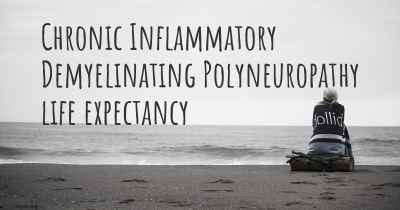Does Chronic Inflammatory Demyelinating Polyneuropathy have a cure?
Here you can see if Chronic Inflammatory Demyelinating Polyneuropathy has a cure or not yet. If there is no cure yet, is Chronic Inflammatory Demyelinating Polyneuropathy chronic? Will a cure soon be discovered?

Chronic Inflammatory Demyelinating Polyneuropathy (CIDP) does not currently have a known cure. However, there are treatments available that can help manage the symptoms and slow down the progression of the disease. These treatments often involve the use of immunosuppressive drugs or intravenous immunoglobulin therapy. Early diagnosis and treatment are crucial in improving the quality of life for individuals with CIDP. It is important to consult with a healthcare professional for personalized advice and treatment options.
Chronic Inflammatory Demyelinating Polyneuropathy (CIDP) is a rare neurological disorder characterized by chronic inflammation of the peripheral nerves. It is considered an autoimmune disease, where the body's immune system mistakenly attacks the myelin sheath, a protective covering of the nerves. This leads to impaired nerve function and a variety of symptoms such as weakness, numbness, tingling, and loss of reflexes.
While there is no known cure for CIDP, there are several treatment options available that can help manage the symptoms and slow down the progression of the disease. The primary goal of treatment is to reduce inflammation and prevent further damage to the nerves.
Intravenous Immunoglobulin (IVIG) therapy is one of the most common and effective treatments for CIDP. IVIG involves infusing high doses of immunoglobulins, which are antibodies derived from donated blood, into the patient's bloodstream. These antibodies help modulate the immune response and reduce inflammation, providing relief from symptoms. IVIG is usually administered every few weeks or months, depending on the individual's response.
Corticosteroids such as prednisone may also be prescribed to suppress the immune system and reduce inflammation. These medications can help alleviate symptoms, but long-term use may have side effects, so they are often used in combination with other treatments.
Plasma exchange, also known as plasmapheresis, is another treatment option for CIDP. This procedure involves removing the patient's blood, separating the plasma (which contains the harmful antibodies), and replacing it with a substitute solution. Plasma exchange helps remove the antibodies responsible for attacking the nerves, providing temporary relief from symptoms. However, the effects are not long-lasting, and the procedure needs to be repeated periodically.
Immunosuppressive drugs such as azathioprine, mycophenolate mofetil, or methotrexate may be prescribed to suppress the immune system and reduce inflammation. These medications are typically used in cases where other treatments have not been effective or in severe cases of CIDP.
Physical therapy and occupational therapy are essential components of CIDP management. These therapies focus on improving muscle strength, coordination, and mobility, as well as managing any functional limitations caused by the disease. They can help individuals maintain independence and improve their quality of life.
It is important to note that the response to treatment varies from person to person. Some individuals may experience significant improvement in their symptoms, while others may have a more gradual response. Regular follow-up with a neurologist is crucial to monitor the disease progression and adjust the treatment plan accordingly.
In conclusion, while there is currently no cure for Chronic Inflammatory Demyelinating Polyneuropathy (CIDP), there are various treatment options available to manage the symptoms and slow down the progression of the disease. These treatments aim to reduce inflammation, modulate the immune response, and improve nerve function. With proper medical care and ongoing therapy, individuals with CIDP can lead fulfilling lives and maintain their independence.








